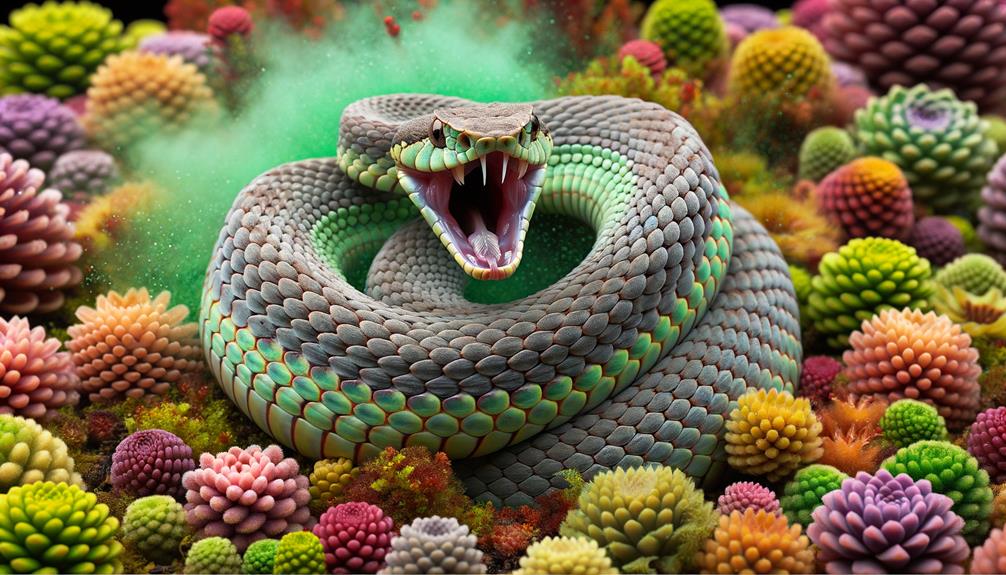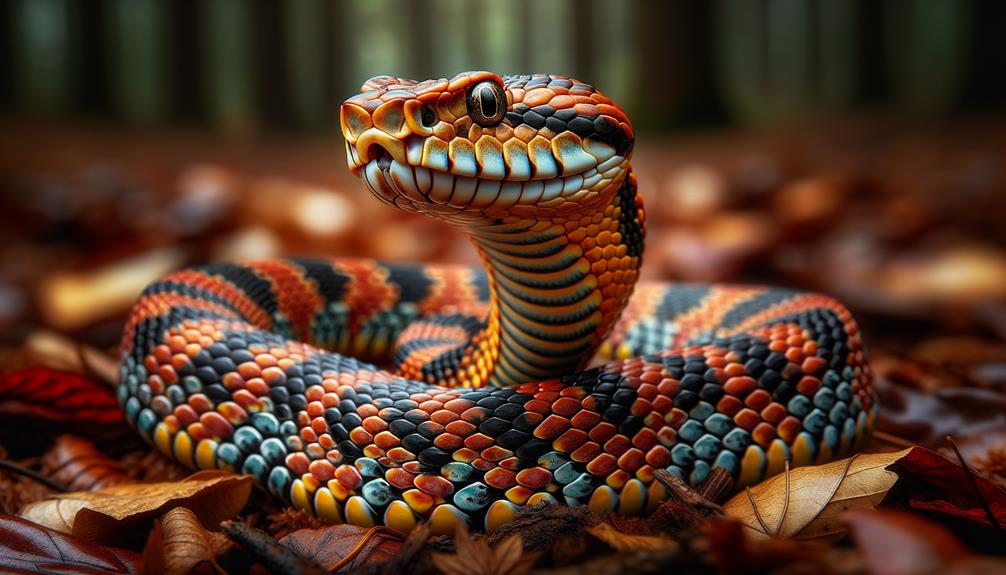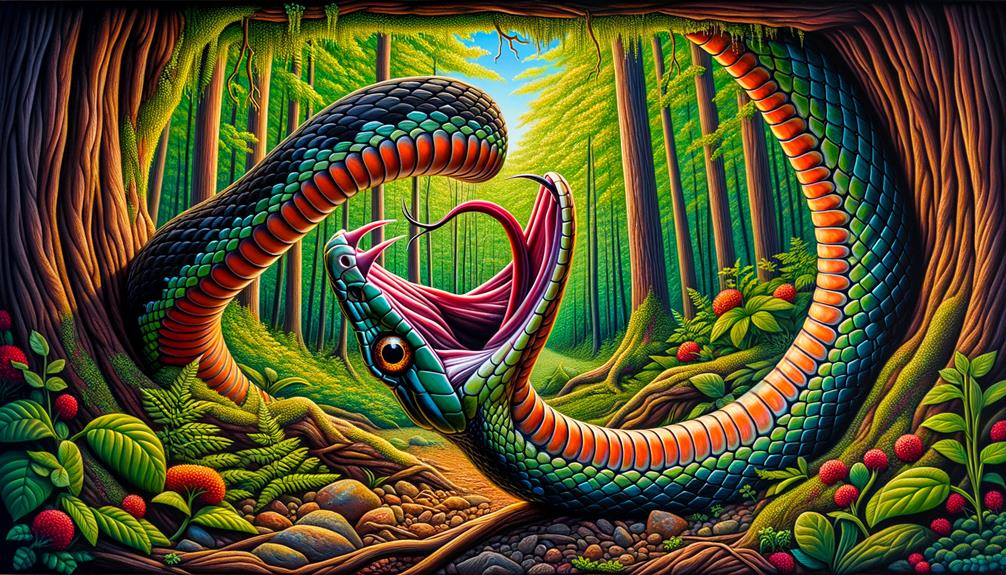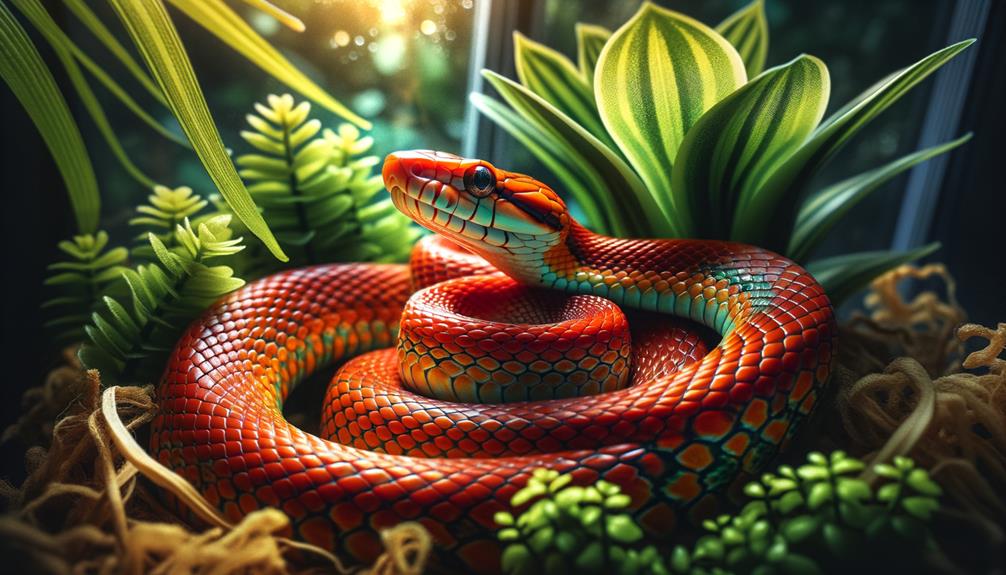I’m fascinated by the remarkable defense mechanisms of hognose snakes. When threatened, they feign death by flipping onto their backs and remaining still. They also mimic cobras, flattening their necks and hissing aggressively. Adding to this, they release a foul, skunk-like odor to deter predators. Their upturned snout serves a practical purpose, aiding in burrowing and locating hidden prey. These behaviors, from mimicry to emitting defensive smells, demonstrate their impressive adaptability in the wild. As you delve deeper into their survival tactics, you’ll discover even more fascinating aspects of these intriguing creatures.
Key Takeaways
Hognose snakes have a unique defense mechanism. When threatened, they flip onto their backs, remaining still and lifeless. They also mimic cobras by flattening their necks and striking with closed mouths, a tactic meant to deter predators. Additionally, they release a foul, skunk-like odor from their musk glands to repel predators. The upturned snout of the hognose snake is specialized for burrowing and locating hidden prey. When faced with a threat, they employ a combination of hissing, lunging, and playing dead to effectively deter predators.
Playing Dead
When threatened, hognose snakes resort to a remarkable defense mechanism: they flip upside down and convincingly play dead. Eastern hognose snakes, in particular, are known for their dramatic performances. Imagine encountering a predator and opting for a theatrical display rather than a fight or flight response – it’s both clever and unique.
The snake will first puff up its body, hiss, and sometimes even strike without opening its mouth. If these initial tactics don’t deter the predator, the snake flips onto its back, opens its mouth, and lets its tongue hang out. This lifeless pose, complete with a slack jaw and a limp body, is an impressive feat of evolutionary adaptation.
Playing dead is more than just a random act; it’s a well-honed defense mechanism designed to make the snake appear unappetizing or diseased. Predators often seek out live prey, and a seemingly dead snake doesn’t fit that bill. This behavior allows Eastern hognose snakes to avoid potential harm without engaging in physical confrontation. Such theatrical displays are rare in the animal kingdom, showcasing the snake’s unique adaptation to survive in the wild.
Mimicking Cobras

Hognose snakes have a fascinating defense mechanism – they mimic cobras. When threatened, they flatten their necks to appear larger and more intimidating. This impressive display is accompanied by loud hissing, making them seem like a formidable foe.
The mimicry goes beyond physical appearance. Hognose snakes also mimic a cobra’s aggressive behavior, striking with their mouths closed. This striking pose is incredibly intimidating and designed to deter predators without engaging in a physical confrontation. It’s a clever trick that allows these snakes to avoid unnecessary battles.
This unique defense mechanism is a remarkable example of evolutionary adaptation. By mimicking a venomous snake, hognose snakes can protect themselves from predators without having to resort to violence. It’s a clever strategy that has helped them thrive in their environment.
Emitting Foul Smells

Hognose snakes have an impressive defense mechanism – they can emit a foul smell to ward off predators. This unique adaptation involves producing a strong, repellent odor from specialized musk glands near their tail. When threatened, they release this musk, which is similar to the pungent stench of a skunk. This overwhelming smell plays a critical role in deterring potential threats, ensuring the snake’s survival in the wild.
Some key aspects of this fascinating defense mechanism include:
- The foul smell is produced by glands near the snake’s tail.
- The emitted odor closely resembles that of a skunk.
- The strong smell effectively repels predators.
In the wild, the ability to emit foul smells provides hognose snakes with a reliable means of escaping predation. This defense mechanism is simple yet remarkably effective, showcasing the snakes’ adaptability and resilience. By leveraging their natural musk production, these snakes can enjoy greater freedom and safety in their natural habitat.
Upturned Snout

Beyond their ability to emit foul smells, these remarkable snakes possess another unique feature: a shovel-like, upturned snout that greatly enhances their burrowing capabilities. This specialized adaptation allows hognose snakes to dig effortlessly through sandy or gravelly soil, creating the perfect shelter and foraging grounds. The upturned snout is not just a simple physical trait; it demonstrates the ingenuity of nature in equipping these snakes for survival.
Hognose snakes use this distinctive snout to locate prey hidden beneath the surface and to burrow into the earth for protection. The shape of their snouts sets them apart from other snake species, highlighting their unique ecological niche. As a result, they can navigate their environment with remarkable efficiency, blending into the landscape and avoiding threats.
Consider the emotional impact of the hognose snake’s specialized snout:
The shovel-like upturned snout evokes a sense of awe at nature’s ingenuity. Their effortless burrowing capabilities inspire admiration for their adaptability. The enhanced foraging capabilities spark fascination with their survival tactics. Their unique ecological niche commands respect for biodiversity. And their efficient navigation earns appreciation for natural design.
In essence, the upturned snout of hognose snakes is more than just a physical characteristic—it’s a symbol of their freedom and resilience in the wild.
Predator Deterrence

When faced with a potential threat, hognose snakes employ an impressive array of defensive tactics that showcase their remarkable adaptability and survival instincts. These snakes are masters of dramatic displays, which are essential for deterring predators.
First, the hognose snake flattens its head and neck, mimicking the hood of a cobra. This visual trick often makes a would-be predator think twice. If the threat persists, the snake escalates its performance by hissing loudly and making lunging motions. These actions are designed to intimidate and confuse the predator, creating an opportunity for the snake to escape.
The hognose snake’s defense mechanisms include:
- Flattening and Puffing Up: The snake flattens its head and neck to imitate a cobra, making itself appear larger and more dangerous.
- Lunging and Hissing: It hisses and lunges aggressively, further enhancing the illusion of being a more formidable foe.
- Playing Dead: As a last resort, the snake may play dead, flipping onto its back and remaining motionless, hoping the predator loses interest.
These behaviors highlight the hognose snake’s incredible ability to adapt and survive in the wild, using intelligence and instinct to navigate threats with finesse.
Observing in the Wild

When I’m out observing hognose snakes in their natural habitats, I keep an eye out for their distinctive upturned snouts as they dig through sandy soils. It’s fascinating to see their dramatic defense displays, like hissing and playing dead, which are effective at deterring predators. I also love watching them mimic cobras by spreading their necks, which adds an extra layer to understanding their survival strategies.
Natural Habitat Preferences
Exploring the natural habitat preferences of hognose snakes reveals their strong inclination for sandy prairies, scrublands, and floodplains, where they can easily burrow and remain hidden. These environments are perfect for the Eastern hognose snake, which thrives in sandy prairies due to the loose soil that facilitates their burrowing behavior. Burrowing not only provides them with a place to hide from predators but also helps them regulate their body temperature.
When I observe these fascinating creatures in the wild, certain characteristics of their preferred habitats stand out:
Sandy prairies offer the ideal environment for hognose snakes, with loose, grainy soil that allows them to dig and hide with ease.
Scrublands provide ample cover from shrubs and low vegetation, making it easier for the snakes to stay out of sight.
Floodplains are rich in both moisture and prey, providing the necessary resources for survival.
Hognose snakes are rarely seen in densely forested areas because they rely on open landscapes to forage and execute their unique defensive displays. Their habitat preferences are a reflection of their adaptability and the crucial role of burrowing in their daily lives.
Defensive Behavior Displays
In the wild, hognose snakes have developed an impressive array of defensive behaviors that are both dramatic and effective at deterring predators. When threatened, they initially resort to loud hissing and flattening their necks to resemble a cobra, creating an intimidating display that often scares off predators. If this tactic fails, they may lunge and hiss more aggressively, while secreting a foul-smelling musk similar to skunk spray, adding another layer of deterrence.
One of the most fascinating aspects of their defensive behavior is their ability to play dead as a last resort. They flip onto their backs, open their mouths, and may even let their tongues hang out, creating a convincing portrayal of death. This dramatic performance can be startling to witness, but it’s incredibly effective at convincing predators they are no longer a viable target.
Here’s a breakdown of their defensive tactics:
| Behavior | Description | Purpose |
|---|---|---|
| Hissing and Neck Flattening | Resembling a cobra to intimidate predators | Threat display to scare off predators |
| Secreting Musk | Emitting a foul odor similar to skunk spray | Deters predators with an unpleasant smell |
| Playing Dead | Flipping upside down and acting lifeless | Trick predators into losing interest |
These remarkable behaviors showcase the hognose snake’s adaptability and impressive survival strategies in the wild.
Frequently Asked Questions
What Defenses Does a Hognose Snake Have?
Hognose snakes have a flair for the dramatic! They’ll hiss, flatten their necks like cobras, release a foul-smelling musk, and even pretend to be dead. It’s a wild survival strategy that’s hard to ignore.
How Do Hognose Snakes Defend Themselves?
Here’s how hognose snakes defend themselves: they hiss, flatten their necks, and emit a foul odor. They also play dead, roll onto their backs, and stick out their tongues. By mimicking cobras, they effectively deter predators.
What Is the Hognose Defense Mechanism?
Hognose snakes have an intriguing defense mechanism. When threatened, they hiss, flatten their necks, mimic cobras, and even pretend to be dead. These behaviors help deter predators and make them fascinating creatures to observe.
What Do Hognose Snakes Do When Scared?
When hognose snakes feel threatened, they exhibit some pretty cool defense mechanisms. For instance, they might hiss, flatten their necks, or release a foul smell to deter predators. Some may even lunge or puff up to appear larger, while others might play dead by flipping upside down and sticking out their tongues.



